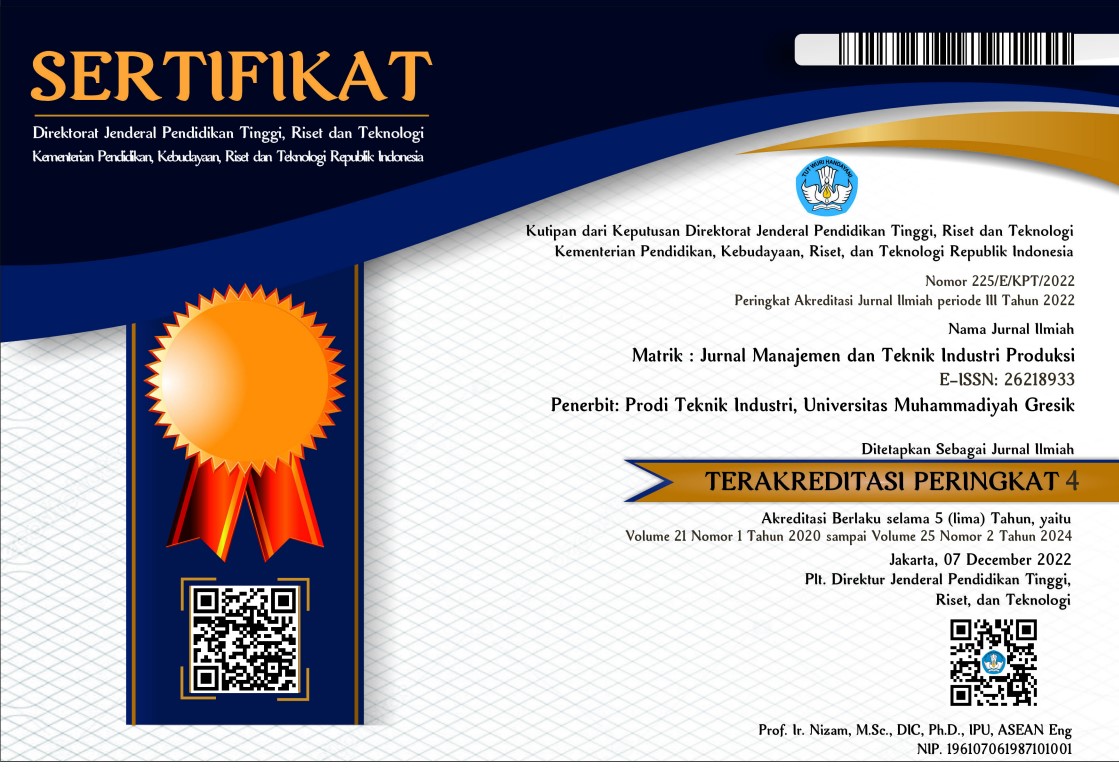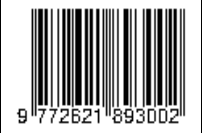Analisis Persediaan Bahan Baku Dengan Menggunakan Metode Economic Order Quantity (EOQ) Dan Period Order Quantity (POQ) Pada Proses Produksi Pintu PVC Di PT. Kencana Inti Andalan (KIA)
DOI:
https://doi.org/10.30587/matrik.v24i2.6739Keywords:
Persediaan bahan baku, Economic Order Quantity (EOQ), Period Order Quantity (POQ)Abstract
PT. Kencana Inti Andalan adalah perusahaan kontruksi yang menawarkan bahan bangunan untuk proyek pembangunan. Karena permintaan yang tidak stabil atau berfluktuasi, pengendalian persediaan bahan baku PT. Kencana Inti Andalan belum optimal. Akibatnya, stok di gudang berkurang, sehingga proses persediaan bahan baku di perusahaan berkurang. Dengan menggunakan metode Economic Order Quantity (EOQ) dan Period Order Quantity (POQ), tujuan penelitian ini adalah untuk menentukan ukuran pesanan, frekuensi pemesanan, dan biaya total persediaan. Hasil dari Economic Order Quantity (EOQ) adalah 602,80 unit, dengan frekuensi pemesanan 10 kali, dan biaya persedaan sebesar 103.724.993,19362. Hasil dari Period Order Quantity (POQ) adalah 255,41 unit, dengan frekuensi pemesanan sebanyak 24 kali.. Dari kedua metode ini di didapatkan selisih biaya persediaan yang di peroleh EOQ lebih menghemat dari POQ, hal ini di kerenakan biaya pemesanan POQ lebih besr di bandingkan dengan EOQ.
References
[2] K. K. Chikaputri, “Comparison Analysis of Economic Order Quantity (EOQ) Method and Min-Max Method on Inventory Management,” AIP Conference Proceedings, vol. 2680, no. 1. 2023. doi: 10.1063/5.0126062.
[3] K. C. Paul, “Computing an EOQ model for deteriorating items with exponentially decreasing demand, parabolic holding cost, and sinusoidal function of deterioration rate,” Int. J. Inf. Technol., 2023, doi: 10.1007/s41870-023-01553-8.
[4] P. supakar, “Neutrosophic trade-credit EOQ model for deteriorating items considering expiration date of the items using different variants of particle swarm optimizations,” Int. J. Syst. Assur. Eng. Manag., 2023, doi: 10.1007/s13198-023-02197-4.
[5] D. K. Katariya, “An EOQ model for deteriorating products with green technology investment and trade credit financing,” Int. J. Procure. Manag., vol. 18, no. 3, pp. 300–320, 2023, doi: 10.1504/IJPM.2023.134190.
[6] H. T. Andriyani, “An EOQ Model for Perishable Product Considering Carbon Emissions Resulting from Refrigerated Truck and Cold Storage,” Lecture Notes in Mechanical Engineering. pp. 247–256, 2023. doi: 10.1007/978-981-99-1245-2_23.
[7] R. R. Patro, “EOQ model with imperfect items and backorder with allowable proportionate discount using cross selling effects,” Int. J. Intell. Enterp., vol. 10, no. 4, pp. 370–383, 2023, doi: 10.1504/IJIE.2023.133820.
[8] S. Mohanty, “A model on an EOQ optimal ordering policy varying with time-dependent cubic demand and variable deterioration under delay in payment conditions,” Int. J. Math. Oper. Res., vol. 26, no. 1, pp. 37–58, 2023, doi: 10.1504/IJMOR.2023.133714.
[9] N. Ahmad, “Carbon Tax and Inflationary Conditions under Learning Effects: A Green EOQ Inventory Model,” Macromol. Symp., vol. 407, no. 1, 2023, doi: 10.1002/masy.202200117.
[10] C. Singh, “Optimizing EOQ model for expiring items with stock, selling cost and lifetime dependent demand under inflation,” OPSEARCH, vol. 60, no. 1, pp. 174–187, 2023, doi: 10.1007/s12597-022-00616-x.
[11] A. Alvina, “Application of Quality Control and Risk Management in Maintaining Product Quality with A Risk Breakdown Structure Approach,” J. Ris. Ilmu Tek., vol. 1, no. 2, pp. 89–101, 2023.
[12] G. Karakatsoulis, “EOQ with supply disruptions under different advance information regimes,” Appl. Math. Model., vol. 125, pp. 772–788, 2024, doi: 10.1016/j.apm.2023.08.012.
[13] M. Pant, “A Channel Financing Policy for an EOQ Model of Fast-Moving Consumer Goods with Fuzzy Approach,” Oper. Res. Forum, vol. 5, no. 1, 2024, doi: 10.1007/s43069-023-00282-9.
[14] Z. Guo, “Implications on managing inventory systems for products with stock-dependent demand and nonlinear holding cost via the adaptive EOQ policy,” Comput. Oper. Res., vol. 150, 2023, doi: 10.1016/j.cor.2022.106080.
[15] P. Mondal, “An EOQ model for deteriorating item with continuous linear time dependent demand with trade of credit and replenishment time being demand dependent,” Int. J. Math. Oper. Res., vol. 24, no. 1, pp. 104–127, 2023, doi: 10.1504/IJMOR.2021.10044421.
[16] R. Sundararajan, “On the EOQ Models with Advertisement-Price-Dependent Demand and Quantity Discount with Expiration Date Under Shortage,” Oper. Res. Forum, vol. 4, no. 4, 2023, doi: 10.1007/s43069-023-00252-1.
[17] J. A. J. Ayhuasi, “EOQ Inventory Model in a Metalworking MSE with Intermittent Demand: A Case Study,” Advances in Transdisciplinary Engineering, vol. 35. pp. 128–139, 2023. doi: 10.3233/ATDE230038.
[18] C. S. Lee, “Considering a Deteriorating EOQ Model Under Stochastic Demand and Shortage Allowed,” Lecture Notes in Production Engineering. pp. 235–246, 2023. doi: 10.1007/978-3-031-18641-7_23.
[19] D. Yadav, “Multi-item EOQ model for deteriorating items having multivariate dependent demand with variable holding cost and trade credit,” Int. J. Oper. Res., vol. 47, no. 2, pp. 202–244, 2023, doi: 10.1504/ijor.2023.131493.
[20] L. C. Wu, “Formulated Optimal Solution for EOQ Model with Fuzzy Demand,” IAENG Int. J. Comput. Sci., vol. 50, no. 3, 2023, [Online]. Available: https://api.elsevier.com/content/abstract/scopus_id/85170256455
[21] S. Maity, “A study of an EOQ model of green items with the effect of carbon emission under pentagonal intuitionistic dense fuzzy environment,” Soft Comput., vol. 27, no. 20, pp. 15033–15055, 2023, doi: 10.1007/s00500-023-08636-5.
[22] M. S. Rahman, “Generalised Arithmetic Mean-Geometric Mean Inequality And Its Application To Find The Optimal Policy Of The Classical EOQ Model Under Interval Uncertainty,” Appl. Math. E - Notes, vol. 23, pp. 90–99, 2023, [Online]. Available: https://api.elsevier.com/content/abstract/scopus_id/85163620408







